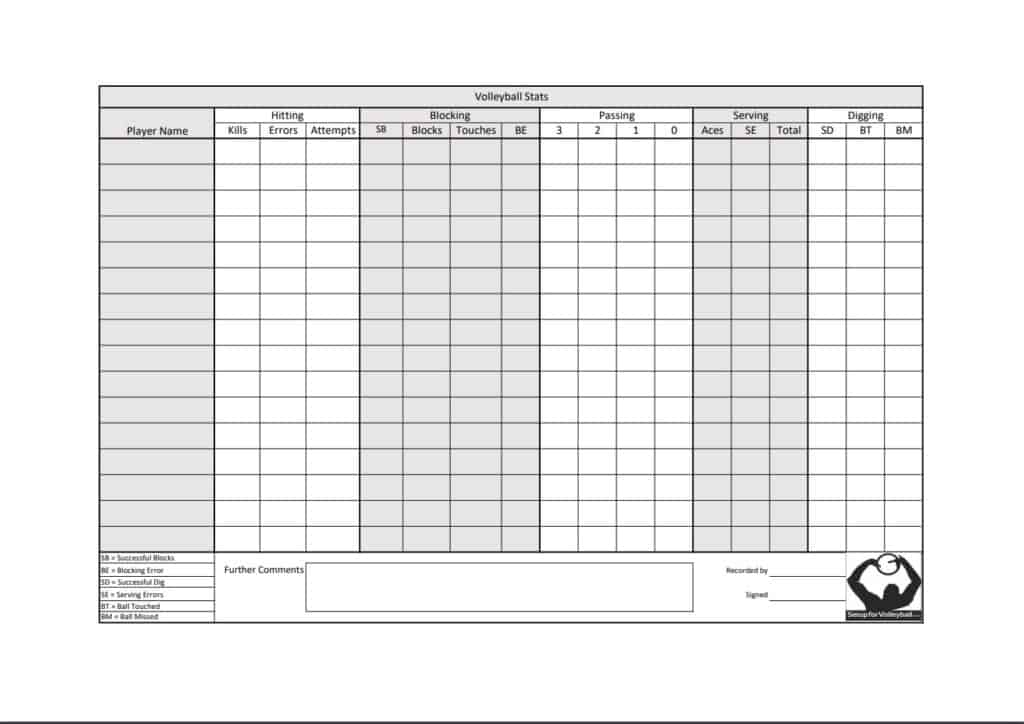Volleyball statistics are more commonly recorded at higher levels of play such as Collegiate or Professional games.
However it is still good practice to understand exactly how and why we record statistics in the first place.
Volleyball statistics are used to record, track and measure a number of different factors such as;
- Number of Aces
- Number of Kills
- Number of Passing Errors
- Number of Hitting Errors
- Number of Assists
To list just a few.
Now it is worth noting that different statistics will be recorded by different clubs depending on what the coaching staff will is most beneficial.
For example some clubs will solely focus on errors to see where their team is losing most of its points. This can be used to put together training regimes to drastically cut down eros.
Whereas other teams may focus on how the team won the most points, this would allow them to be much more effective in the offense as they know where their best chance of success is in any given situation.
As mentioned above the list is not exhaustive and many clubs will record different statistics.
However, with that being said I am hoping in this article to teach you about how to record statistics and more importantly which statistics you should start recording to give you a competitive edge over any opposition you face.

Table of Contents
Statistics You Should Be Recording
So as I mentioned above statistics can be a very personal thing depending on what you are trying to achieve, however, with that being said, if you have never recorded any stats before, I suggest you start with these few basic ones as they will certainly benefit your team or even individual performance massively.
Passing Errors

The first statistic I feel is really important to record and understand is the amount of passing errors each player has.
The term is fairly self explanatory however, a passing error is when a player makes a mistake whilst passing the ball, this can be from service, in normal play or even when covering the hitter.
Now as I said statistics can be recorded in many different ways, with this in mind, a team may want to record passing errors from opposition serves as this would highlight players who may struggle with serve receive.
Alternatively a team may want to record passing errors within rallies as this might highlight some issues relating to base positions.
Using these statistics and catering them to your teams needs can be a really powerful tool.
Recording passing errors is not designed to highlight who is having a bad game or who isn’t a very good passer.
It is designed to highlight who might be struggling with passing so we can ensure they get plenty of repetitions in training and we can solely work on improving their consistency.
By drastically reducing the amount of passing errors a team has it can drastically increase the success a team has.
Hitting Errors
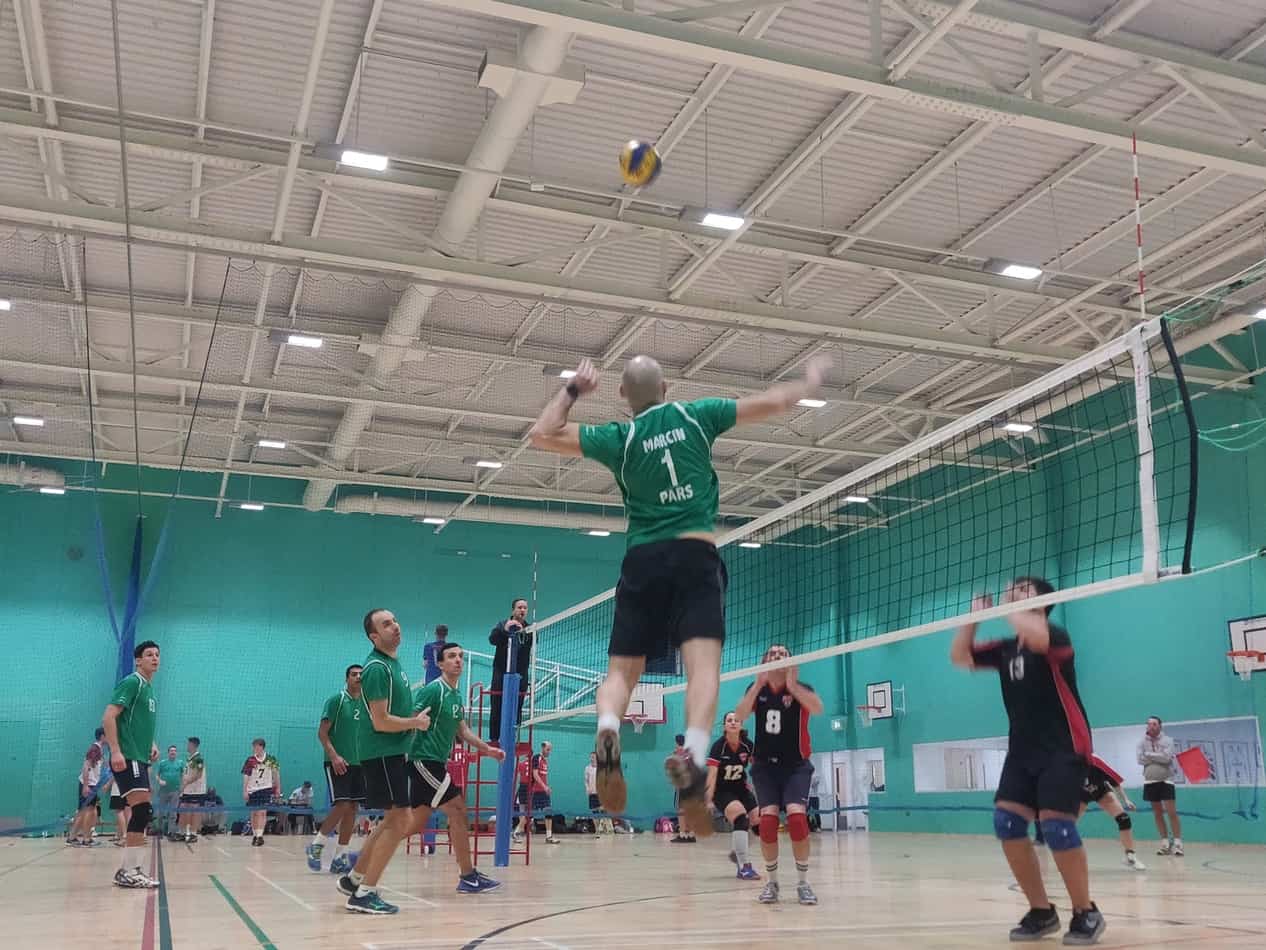
Much like passing errors this stat monitors when a player makes a hitting error.
A hitting error is classed as a mistake made when attacking the ball, this would traditionally be a spike.
A more advanced version of this statistic would be to record a hitting error each time one occurs, however, have a different mark if the error was forced by the opposition as opposed to an unforced error.
An example of this would be if the player made a hitting error against a 3 man block versus a hitting error where there is no block.
By diving a little bit deeper into those stats it could give you a great insight into where the majority of the hitting errors are coming from.
If the hitting errors are coming from free nets (Hitting opportunity with no block) this could indicate an issue with jump timing, poor form or technique or other factors that could easily be rectified with coaching.
If the hittin errors are a result of the opposition forcing this area this could indicate a couple of things.
Either the setter isn’t deceptive enough meaning the opposition are reading the play and applying a lot of blocking pressure.
Or, it may just show that the team needs more practice in pressured situations.
By isolating these hitting errors it allows training to be really focused to start to iron out these errors.
Although focusing on the negative points may seem scary it is vital to know what a players weakness is to help them develop and grow as a player.
Service Aces

Now we start moving into the more positive statistics that focus on the good points rather than highlighting the bad.
An ace in volleyball is when a point is scored directly from the serve.
This includes a serve that hits the floor within the court without a player touching it at all, as well as a tough serve that the other team gets a touch on but is unable to string together a return.
Recording how many aces are scored by individual players and as a team can highlight some really important things.
For example if as a team there are not many aces scored over the course of a game, this could indicate that the team is not applying enough pressure with their serves.
It also allows you to highlight individual players that may be struggling with the concept of getting aces.
Using this information allows you as a team to dedicate training sessions towards service pressure, it can also allow you to coach individual players and see if perhaps adapting their technique may result in more aces.
An interesting note to add.
If you monitored service errors as well as Aces it may actually highlight that the players are trying too hard to get aces rather than just focusing on applying pressure to the receiving team.
Number of Kills
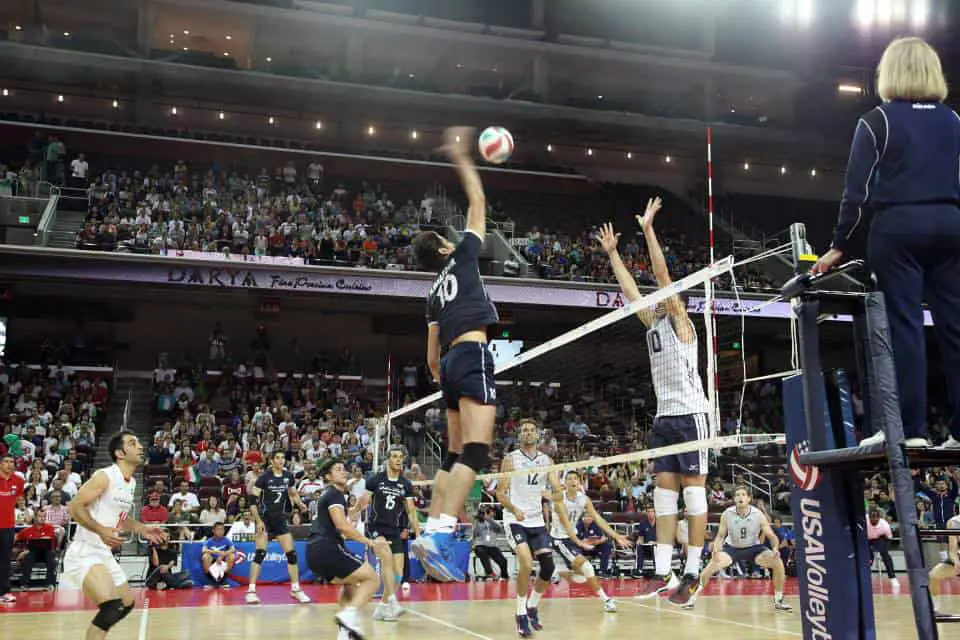
Let’s be honest this is the one we all want to track and the one stat that everybody (except maybe the libero) wants to know.
A kill in volleyball is when a point is grounded from a spike or attack.
It is called a kill because it literally stops the rally dead and a point is won.
Knowing this stat can be vital to learn just how effective a team’s offense really is.
The statistic becomes even more powerful if you record not only kills but also attempts.
Coupling these two statistics together will give any player a true reflection of how effectively they are hitting the ball and how prolifically they are scoring points for their team.
Again by knowing these numbers it allows teams to focus their next training around this concept by introducing hitting under pressure.
Successful Blocks (Both Kills and Touches)

The last statistic which can be really powerful is recording the number of successful blocks.
Now when you hear the term ‘successful block’ you probably immediately think of a ball which is blocked and results in a point.
However, I actually like to look at blocking in a more general sense.
The aim of blocking is prevent the ball from crossing on to your side, this to me would suggest that any ball that is blocked back on to the opponents side is successful whether it immediately results in a point or not.
Personally I think both block kills and touches should be counted even if they are noted on the stat sheet differently.
If a player is consistently getting blocks but very rarely getting block kills (AKA Roofs or stuffs) it could mean that they are getting in the right area but perhaps they don’t quite finish their block correctly or maybe they don’t press over enough.
Knowing these numbers can be a really powerful tool as it can turn a good blocker into a blocking machine.
Another statistic that is often recorded in regards to blocking is whether it was a solo block or assist block.
A solo block is when one player blocks the ball on their own in a 1v1 situation.
An assist block is when two players jump and block the ball together, now when I say together I don’t necessarily mean they both got a touch on the ball when blocking, I simply mean they both jumped to block the ball.
If the ball is blocked when two players (or more) are blocking it would be marked down as an assist block regardless of who got the final touch on the block.
How To Record Stats Using Stat Sheet
Now I could go into great detail on all the different types of ways you can record statistics.
However, as I mentioned before, there are so many different ways in which these can be recorded and depending on exactly what you are trying to achieve, the traditional ways of recording statistics may not work for you.
For example many people when it comes to recording things such as successful passes, most people tend to use the 3,2,1 & 0 format.
What this effectively means in simple terms is how good was the pass.
Was the pass:
- 3 – Perfect
- 2 – Good
- 1 – Kept in play
- 0 – Error
Now although this is the most commonly used system, by no means is this the only way of measuring passes.
For example if you were coaching a team of a lesser standard you may just mark down whether the pass was up for the setter or whether it was an error.
Now many of you may have just clicked on this article because you saw that the Free stat sheet in the title.
If you did that is fine but obviously for me to create and give away a free stat sheet I need to create one that caters to everyone so with that being said I am going to quickly cover how you fill out the stat sheet I provide.
Player
So starting out in the far left column we have the player name, this one is nice and self explanatory, you simply put the players name or number down in the row where their stats will be recorded.
Hitting

Moving onto the next column we have hitting.
Now under hitting you will see the following headings.
Kills
Number of points won directly from the attacking shot
Errors
Number of hitting errors resulting in a point to the other team
Attempts
Total hitting attempts
These three will give you a clear indication of how successfully a player is hitting.
Using the three figures above you can actually work out hitting percentages which can be a great way to monitor players improvements over the year.
Blocking

Under blocking you will again find a few subheadings, these headings are:
Successful Blocks
A successful block is counted as when a ball is blocked and a point is won directly as a result of the block.
Blocks
In this section I have noted this as a block that is successful in terms of stopping the opponents hitting over the net however maybe it is picked up or recycled. So it is a block that makes the ball go back on the opponent’s side without winning the point.
Touches
A touch is when the blocker makes contact with the ball but it is unable to prevent it from travelling back on the opponent’s side
Blocking Errors
A blocking error is pretty self explanatory, this is when a point is lost as a result of the block. An example would be if the blocker hasn’t formed their block and the ball hits the block but falls on their own side.
Passing

Now I actually touched on the method of recording statistics that I use above, that is the 3, 2, 1 & 0 scoring method.
Rather than looking at this as a perfect pass, good pass etc.. and easy way to determine what score the pass should receive is to look at the number of setting options the setter has.
For example with a perfect pass they would have at least 3 setting options whereas if the pass was good but perhaps off the net they might not be able to use the middle player and only be able to set the outside or opposite (Right side Hitter) So this would be a 2.
Serving
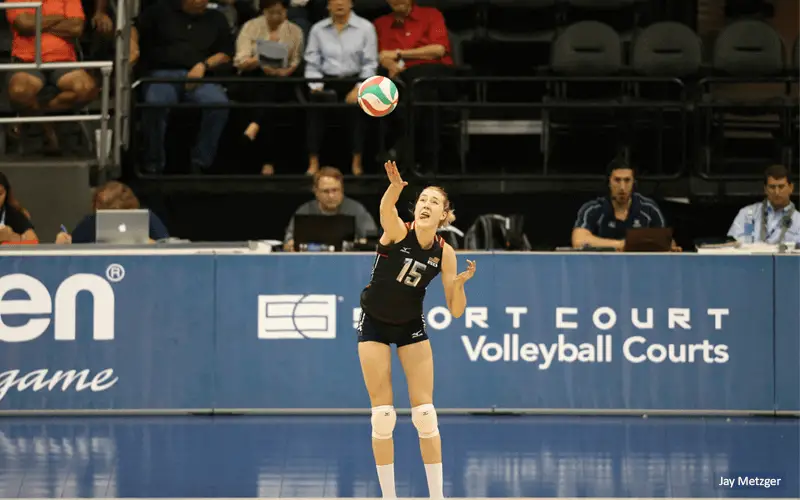
Under serving we ideally want to track the consistency of each server.
To do this we have the following sub-headings
Aces
An ace in volleyball is when the ball is served and a point is won as a direct result of the serve.
An example would be if the ball is served and no player from the other team touches it before it lands in court.
Serving Errors
An error in serving is as the name suggests an error, this is when the point is lost as a direct result of the serve.
For example the serve landing outside the court lines on the oppositions side
Total Serves
This is the total number of serves any one player has throughout the match. Understanding this number can help identify players that may need more practice serving or they may be consistent servers but need to serve tougher to get more aces.
Digging
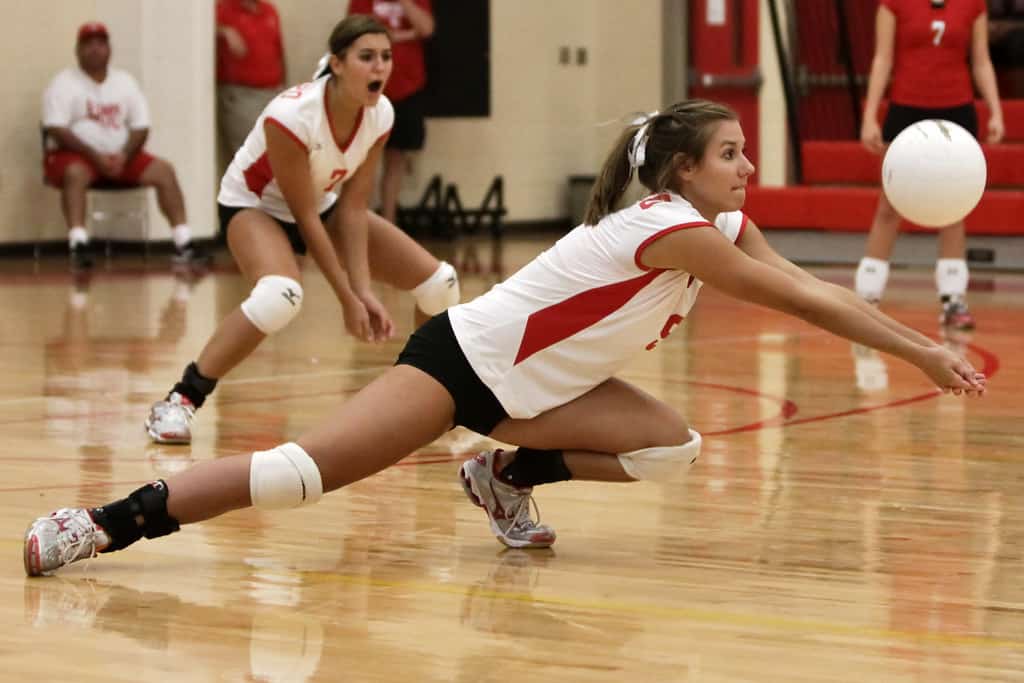
Now honestly this stat can sometimes be hard to monitor but I am always interested in the number of successful digs, using this stat you can determine if potentially certain players aren’t understanding where the base position is.
Successful Digs
A successful dig in my eyes is a ball that it kept up, alive and in play to allow a setter to be able to set the ball
Ball Touched
A ball touched is when a player gets a contact on the ball but doesn’t necessarily get the ball up.
Ball Missed
This stat can be tricky to monitor as you would need to be sure the ball landed in a certain player’s zone to properly classify it as a missed ball.
An example would be if an opposition player spiked the ball down the line and the player at position 1 missed that, it would go down as a missed ball for the player at position 1.
Free downloadable Volleyball Stat Sheet
I have attached a screenshot of the volleyball stat sheet.
If you click the below image your download will start automatically.
Go get number crazy.

